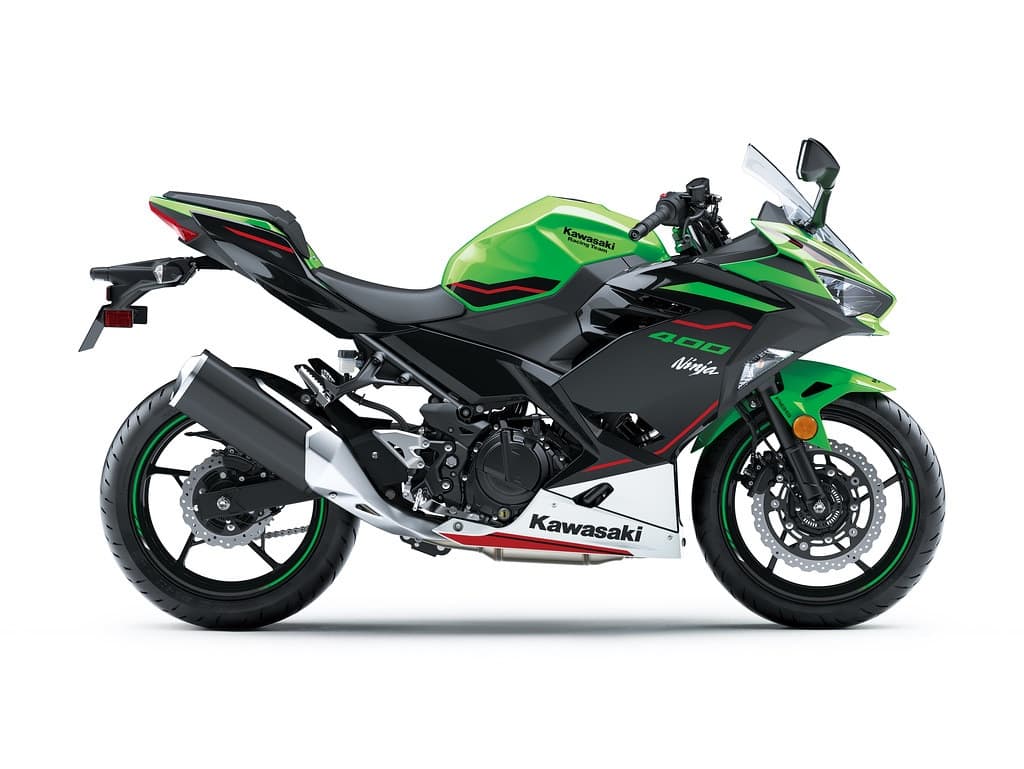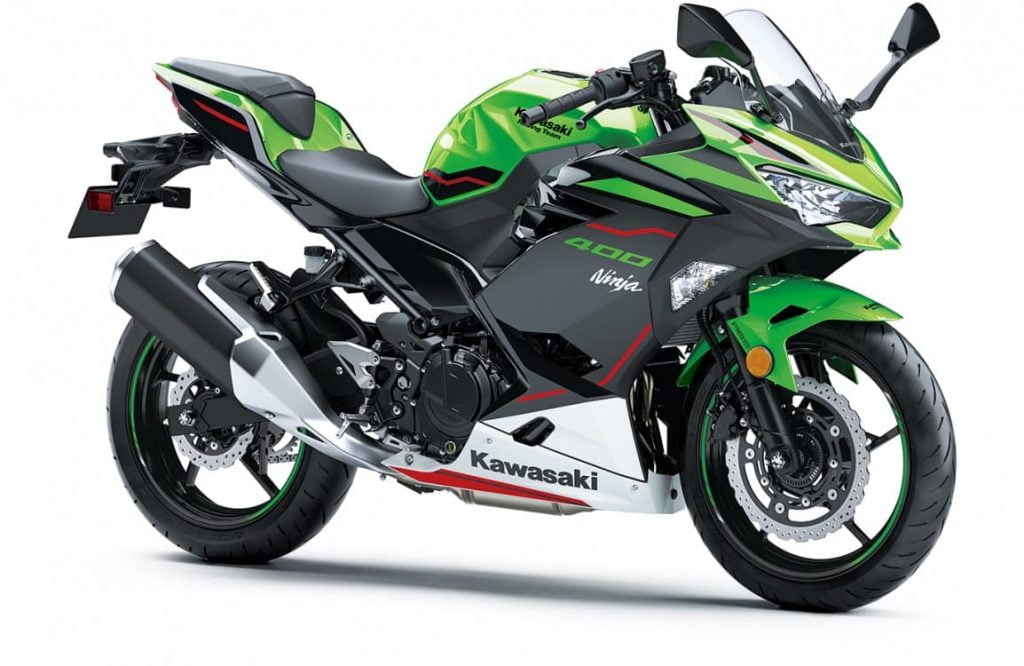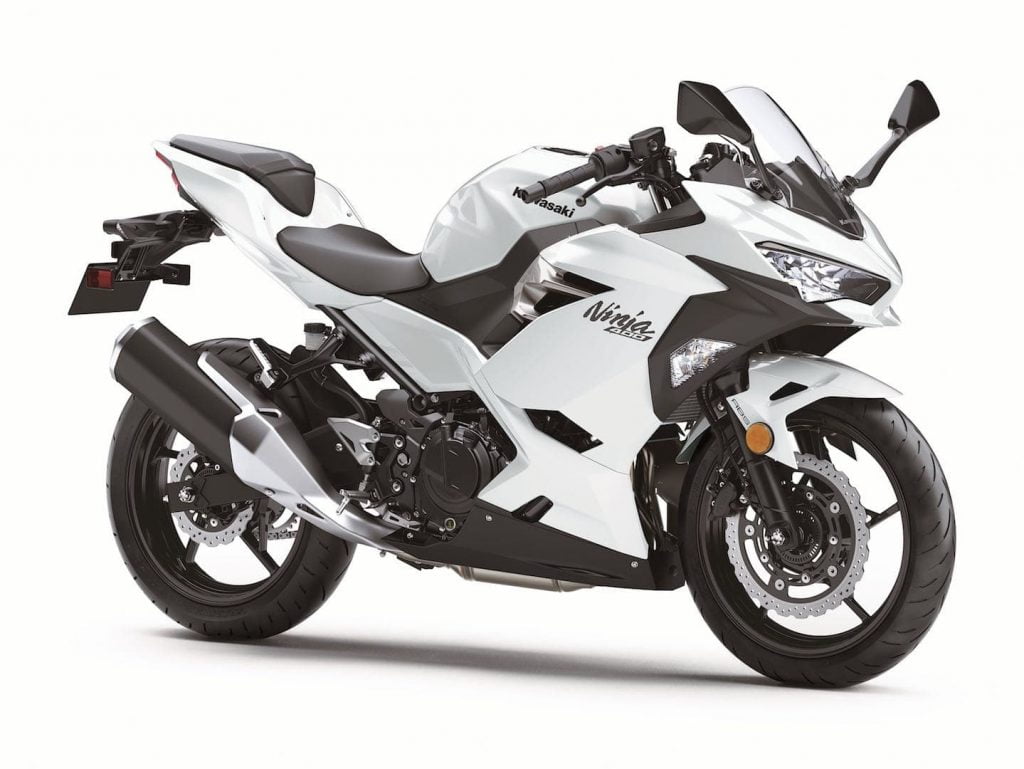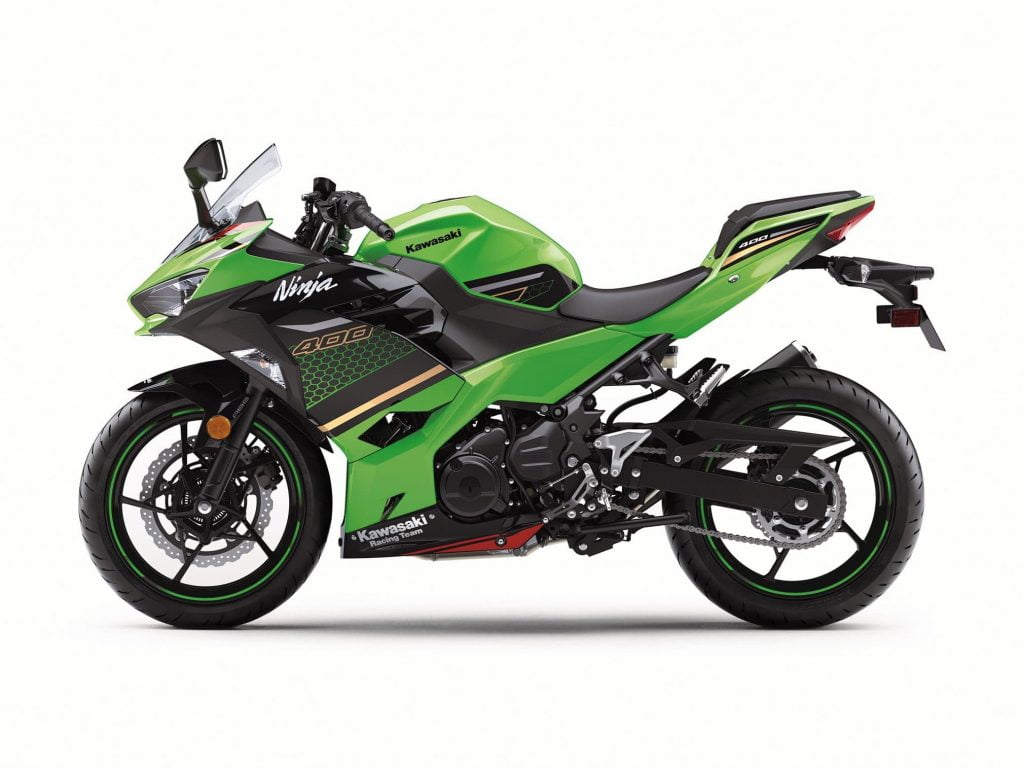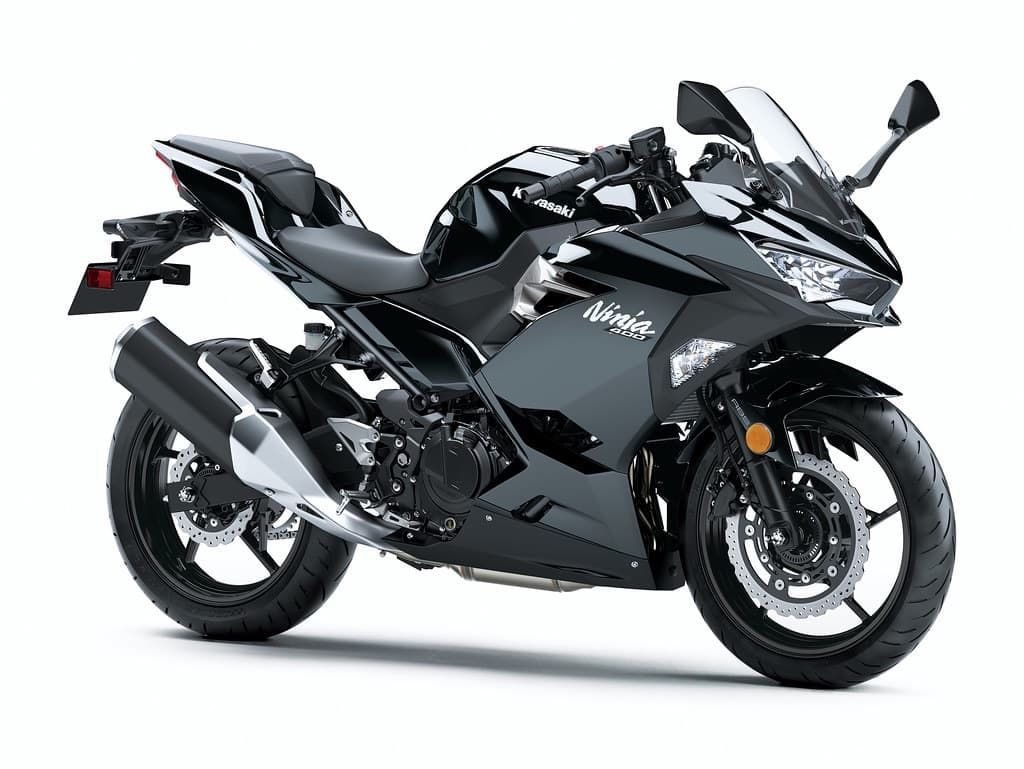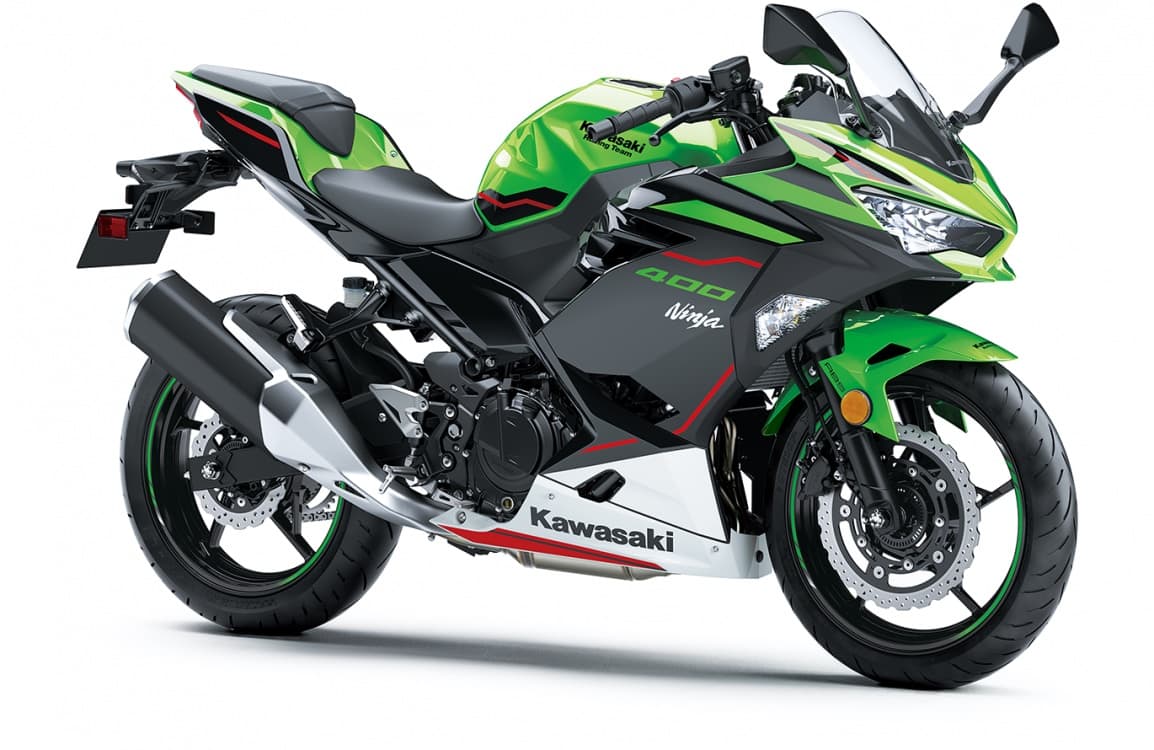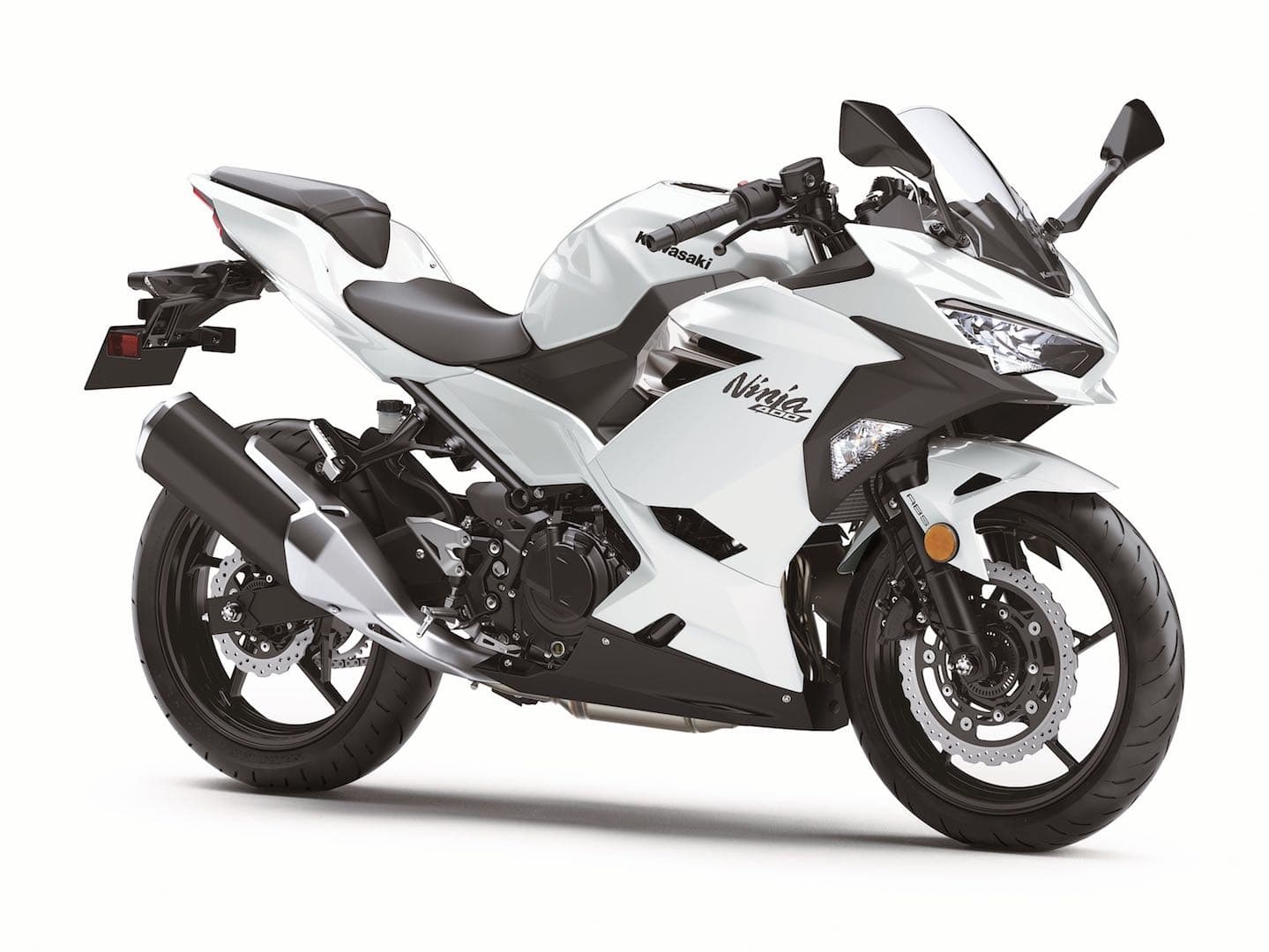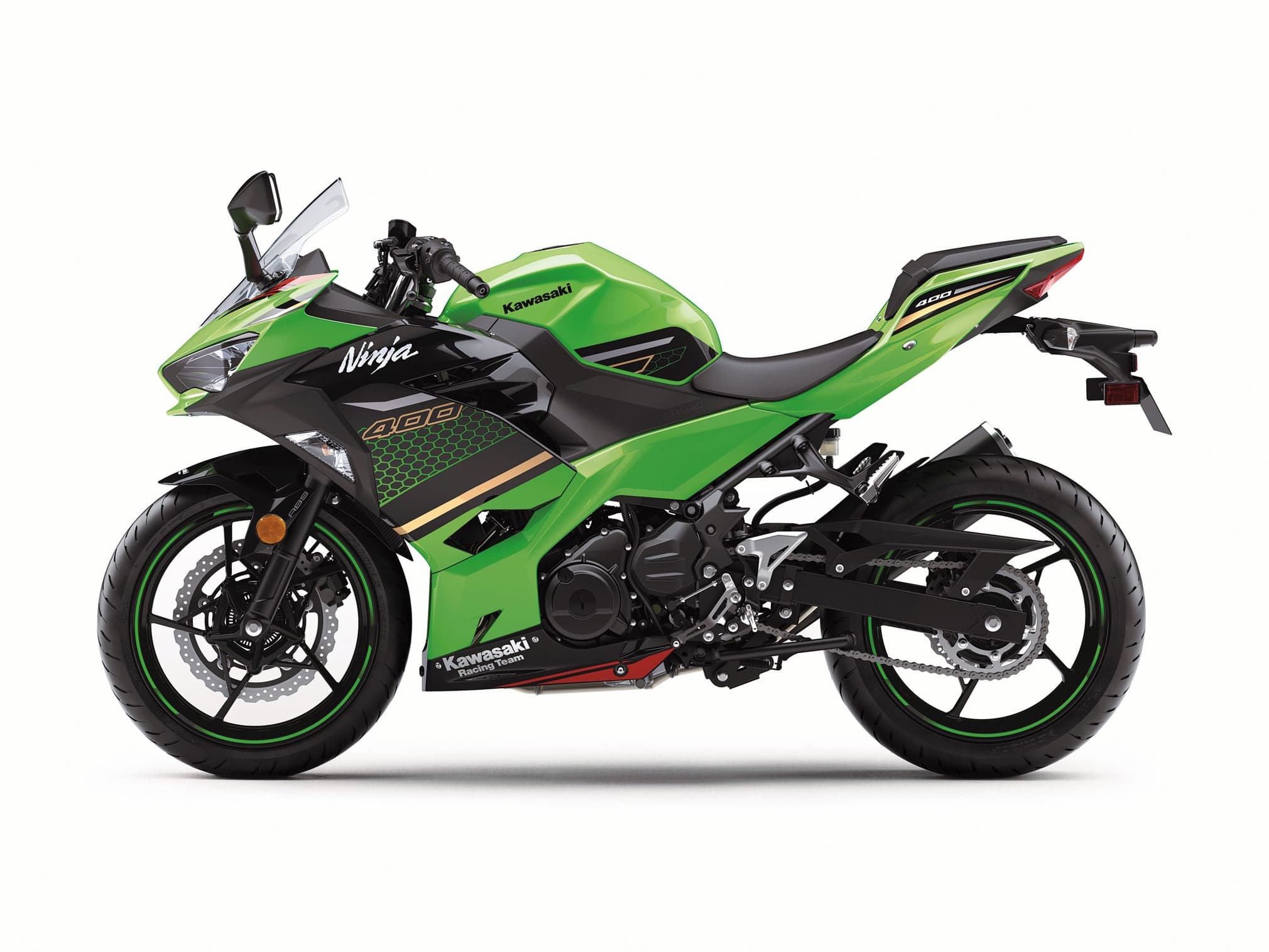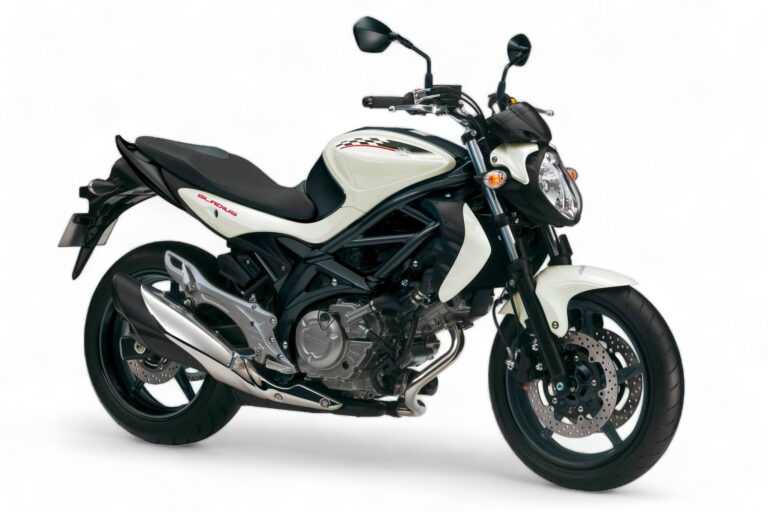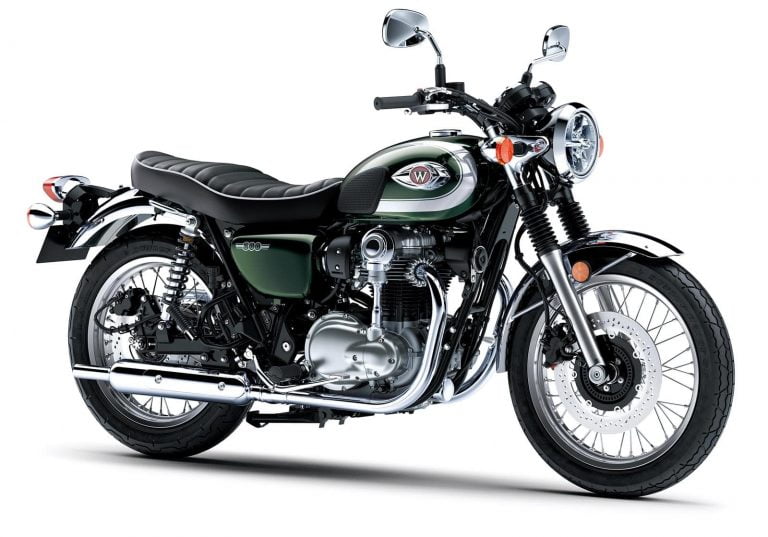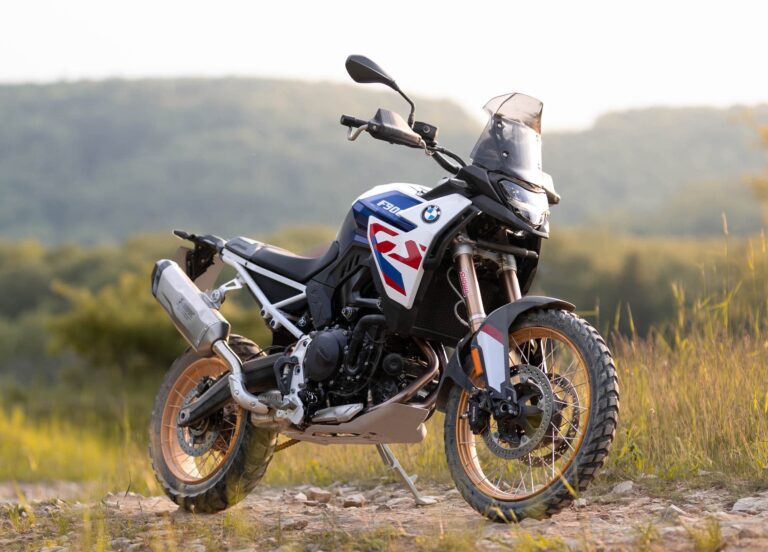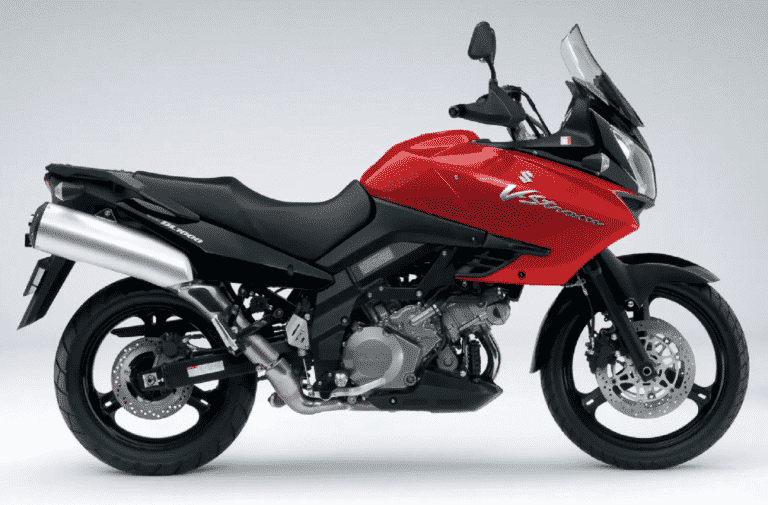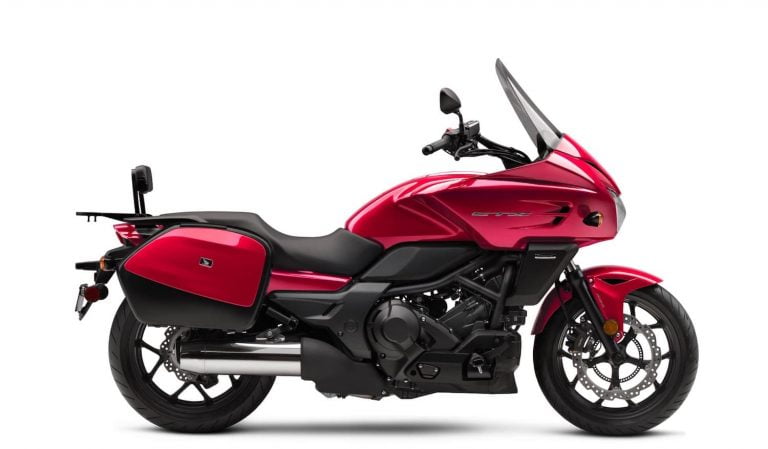Kawasaki Ninja 400 (EX400) Complete Maintenance Schedule
This is the full maintenance schedule for the Kawasaki Ninja 400 — when to change your air filter, spark plugs, and more.
The Ninja 400 is the successor to the Ninja 300, but it is better in every way. Well, in two important ways — it’s more powerful, and lighter.
The Ninja 400 is powered by a 399cc liquid-cooled parallel twin engine with four valves per cylinder and dual overhead cams. It runs a modest 11.5:1 compression ratio, making a beginner-friendly but still feisty peak power of approximately 33 kW / 45 hp at 10000 rpm. Final drive is via a six-speed box and chain.
The Kawasaki Ninja 400 is also the sibling to the Z400, which is the same fundamental bike (same engine / drivetrain and chassis) but in naked format.
The Ninja 400 is still an entry-level bike but is the kind of bike many people find themselves downsizing to and having the time of their lives on it.
From 2024, Kawasaki replaced the Ninja 400 with the Ninja 500. See its maintenance schedule here.
This post was originally published on April 27, 2021, but has since been updated with service intervals, tire specs, chain maintenance guidelines, and more.
This site has links for things like oil and spark plugs from which we earn a commission (which unfortunately nobody can save, not even us). If you appreciate this work, then please use those links. Thanks!
Kawasaki Ninja 400 Service Intervals
The basic service interval for the Kawasaki Ninja 400 is either every 7600 miles (12000 km) OR every year. At any of those periods, change the oil and filter, and check the schedule to see what you need to adjust inspect, lubricate, or replace.
The valve clearance inspection interval is a generous 24000 km (15000 miles). The Ninja 400’s parallel-twin engine is easy to service, too, as there’s just one cylinder head, and no need to drop the oil to do a valve service.
The Ninja 400 has a liquid-cooled engine, so make sure you keep the coolant fresh, along with the brake fluid.
What you need to service your Kawasaki Ninja 400
Servicing your Ninja 400 is easy! You just need a bunch of basic motorcycle maintenance tools, some floor space, and of course the following consumables.
| Part | Kawasaki Ninja 400 & Z400 Spec |
|---|---|
| Oil | You need 2.0L (2.1 US qt) of SAE 10W-40 engine oil “with API SG, SH, SJ, SL or SM with JASO MA, MA1 or MA2 rating”, preferably Kawasaki 10W-40 Engine Oil, or another high-grade synthetic like Motul 7100 10W-40. Don’t over-torque the drain bolt (spec is 30 Nm/22 lb-ft per the manual) — use a torque wrench if you don’t have experience with how much torque is enough. |
| Oil filter | Oil filter is part 16097-0008, or you can use Hiflofiltro HF303RC. Torque for oil filter is 17.5 Nm (12.9 ft-lb) (use a torque wrench, and it’s easier on the aftermarket one) |
| Front brake pads | Genuine part number for front brake pads is 43082-0081 for Ninja or Z 300/400. Get double-sintered EBC brake pads for better bite and wear — code FA197HH. |
| Rear brake pads | Genuine part number for rear brake pads is 43082-0128 (or same as front… same pads!). Get double-sintered EBC brake pads for better bite and wear — code FA197HH. |
| Spark plugs | NGK LMAR9G, with a spark plug gap of 0.7-0.8mm, torqued to 13 Nm or 9 ft-lb (use a torque wrench) |
| Air filter | Use the K&N air filter KA-4018. |
| Cable lubricant | Remember to lubricate your clutch cable (and brake cables if you have them) with a cable lubricant. Protect All Cable Life is a good general-purpose lubricant. |
| Chain lubricant | The chain needs to be lubricated every 600 km/400 miles (or more, if it gets wet/dirty). Motul chain paste is cheap and well-loved. |
| Brake fluid | Spec is to use DOT-4 brake fluid. |
| Coolant | Use nitrate-free, phosphate-free, ethylene glycol-based coolant with anti-corrosion inhibitors, e.g. Valvoline Zerex G05 |
| Grease | Use a lithium soap-based grease for all the important greasing points. |
Maintenance schedule for the Kawasaki Ninja 400
Below is the full maintenance schedule for the Ninja 400.
Notes:
- In the original manual for the Ninja 400, some items are mentioned as “dealer inspection”. Things like checking the idle speed or the coolant level. However, the bike is easy to service — it’s up to you if you want to take it to a dealer or not.
- For clarity, we’ve also separated out the “annual inspection” items from the regular items that need replacement less often (other than engine oil).
| km x 1000 | 1 | 12 | 24 | 36 | 48 | |
|---|---|---|---|---|---|---|
| mi x 1000 | 0.6 | 7.6 | 15.2 | 22.8 | 30.4 | Every |
| Perform annual inspection (see below) | ✓ | ✓ | ✓ | ✓ | ✓ | Year |
| Engine oil — Replace (Kawasaki 10W-40 Engine oil) | ✓ | ✓ | ✓ | ✓ | ✓ | Year |
| Oil filter — Replace (HF303RC) | ✓ | ✓ | ✓ | ✓ | ✓ | Year |
| Spark plug (NGK LMAR9G) — Replace | ✓ | ✓ | ✓ | ✓ | ||
| Air cleaner element — Replace (K&N KA-4018) | ✓ | ✓ | ✓ | ✓ | More often if riding in dust / off-road | |
| Valve clearances — Inspect | ✓ | ✓ | ||||
| Idle speed — Inspect | ✓ | ✓ | ✓ | ✓ | ✓ | |
| Engine vacuum synchronization — Check | ✓ | ✓ | ✓ | ✓ | ||
| Fuel filter — Replace | ✓ | ✓ | ||||
| Fuel hose — Replace | 5 years | |||||
| Evaporative emission control system (if fitted) | ✓ | ✓ | ||||
| Coolant, coolant hoses, and O-rings — Replace all | ✓ | 3 years | ||||
| Air suction system — Inspect | ✓ | ✓ | ✓ | ✓ | ||
| Drive chain wear — Inspect | ✓ | ✓ | ✓ | ✓ | ||
| Drive chain guide wear — Inspect | ✓ | ✓ | ✓ | ✓ | ||
| Brake fluid (front and rear) — Replace (Castrol DOT 4) | ✓ | ✓ | 2 years | |||
| Brake hoses — Replace | 4 years | |||||
| Rubber parts of brake master cylinder and caliper – Replace | ✓ | 4 years | ||||
| Rear suspension — Lubricate | ✓ | ✓ | ||||
| Steering stem bearings — Lubricate | ✓ | ✓ | 2 years |
Annual inspection
Below is the list of maintenance items for the Kawasaki Ninja 400 — things to check / lubricate every service (per the schedule above).
| Kawasaki Ninja 400 Annual Inspection |
|---|
| Throttle control system — Inspect (play, smooth return, and no drag) |
| Brake system — Inspect function |
| Brake operation (effectiveness, play, no drag) |
| Brake fluid level — Check / top up (Castrol DOT 4) |
| Brake pad wear (not as critical at break-in) Inspect more often if riding in dusty / wet conditions, or aggressively |
| Brake light switch operation — Check |
| Fuel system — Inspect (no leaks, kinks, damaged hoses) |
| Cooling system — Inspect (no leaks, kinks) |
| Coolant level — Inspect, top up as necessary (Zerex G05) |
| Clutch operation — Inspect (play, engagement, disengagement) |
| Wheels and tires — Check condition (no dents, damage) |
| Wheel bearings — Check for damage / looseness |
| Tire air pressure — Check / adjust (See specs below) |
| Suspension system — Check for leaks, smooth operation Not required at break-in service |
| Steering play — Check for smooth operation, no notchiness |
| Electrical system — Check all lights, signals, and switches work |
| Chassis parts — Lubricate |
| Bolts, nuts, and fasteners — Check condition, tighten as necessary |
Maintaining Your Chain on the Kawasaki Ninja 400
It’s important to maintain your chain on the Ninja 400, as on any chain-driven motorcycle. Use a good-quality chain lubricant like Motul chain paste, or a Motul chain care kit which comes with a couple of handy tools to maintain the chain.
Kawasaki recommends you follow the following chain maintenance schedule:
| Chain maintenance item | Every |
|---|---|
| Check drive chain lubrication condition, lubricating if necessary (Motul chain paste) | 400 mi / 600 km |
| Check drive chain slack, adjusting if necessary | 600 mi / 1000 km |
Notes:
- Do these items (checking/adjusting slack, and checking/applying lubrication) more often if you ride your Ninja 400 in dusty or rainy conditions.
- Always lubricate the chain after washing the motorcycle.
Tire sizes and pressures for the Ninja 400
The manual specifies the following tire sizes, pressures, and brands (that it ships with, though people rarely stick with them).
Stock, the Ninja 400 ships with Dunlop Sportmax GPR tires, but you can fit any street/sport hoops to it.
| Tyre | Size | Tire pressure (cold) |
|---|---|---|
| Front | 110/70R17 M/C 54H | 200 kPa/28 psi |
| Rear | 150/60R17 M/C 66H | 225 kPa/32 psi |
About the Kawasaki Ninja 400
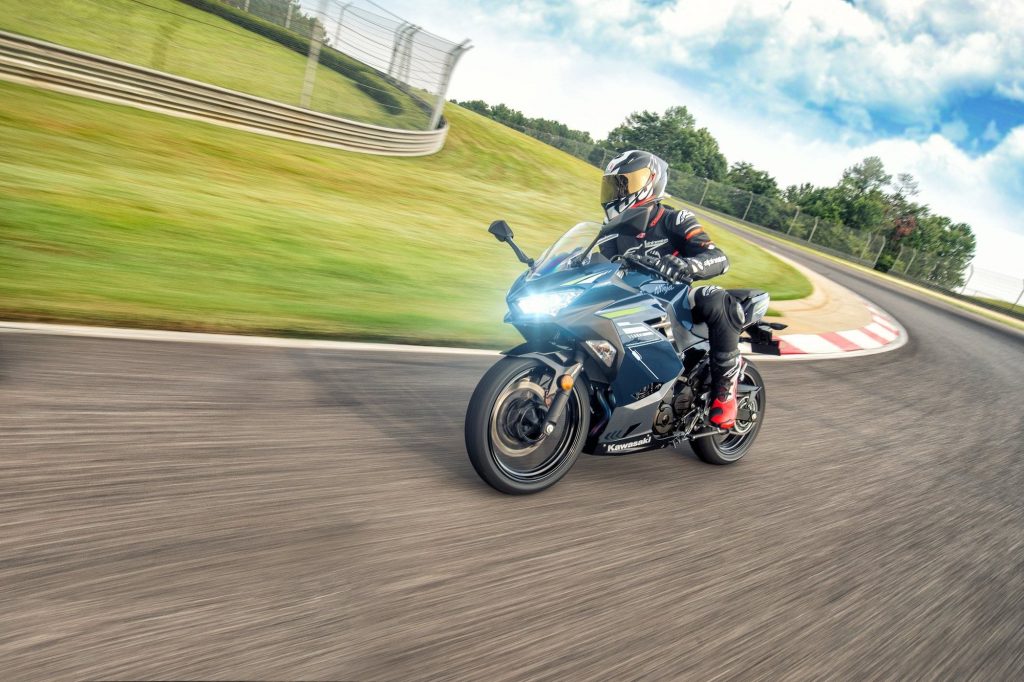
The Ninja 400 was first released in 2018 (launched a few months earlier), replacing the Ninja 300, which was itself an improvement on the long-lived and much-loved Ninja 250.
It’s a very well-loved beginner motorcycle, but also with a few mods makes a great entry-level track motorcycle that is suitable for tighter circuits that don’t really give big bikes the advantage on long straights.
(The first mod anyone makes when going to the track, by the way, is modifying the suspension — gold valve emulators or cartridges up front.)
The 399cc water-cooled parallel twin doesn’t make a terribly inspiring sound, as you’d expect from a small engine with a 180-degree crank. It’s a far cry from the lively bark of the CP2 engine in the Yamaha MT-07, for example.
But what it doesn’t have in character it makes up for in eagerness to rev and willingness to fly way up the tachometer to high RPMs. This is where the Ninja 400 is different to competitors like the Honda CBR500R. On paper, they have similar specs, though the Ninja is heavier. But in reality, the CBR500R seems to run out of puff when the little 400 keeps going.
The Ninja 400 is still a great everyday motorcycle, though. It is comfortable, with high clip-on style handlebars, and doesn’t force you to crouch way down over the tank.
The Ninja 400 comes standard with ABS in most markets (or with it as an option for pennies more), is frugal on gas, and very low on maintenance — see above, if you don’t believe us, with maintenance intervals every 12000 km (7500 mi) and mostly requiring “inspecting” things.
In fact, the Ninja 400 is such a practical, fun motorcycle, that it’s a popular target for people who decide they’ve had enough of pottering around on superbikes and want something they can really fly with. It’s a real rider’s bike, for the right kind of roads.
Just keep the fluids up to date, check the valves, replace brake pads and the chain occasionally, and it’ll go forever… until you crash it.
Manual for the Kawasaki Ninja 400
The above maintenance schedule was transcribed from the manual for the Ninja 400, with reference to parts diagrams.
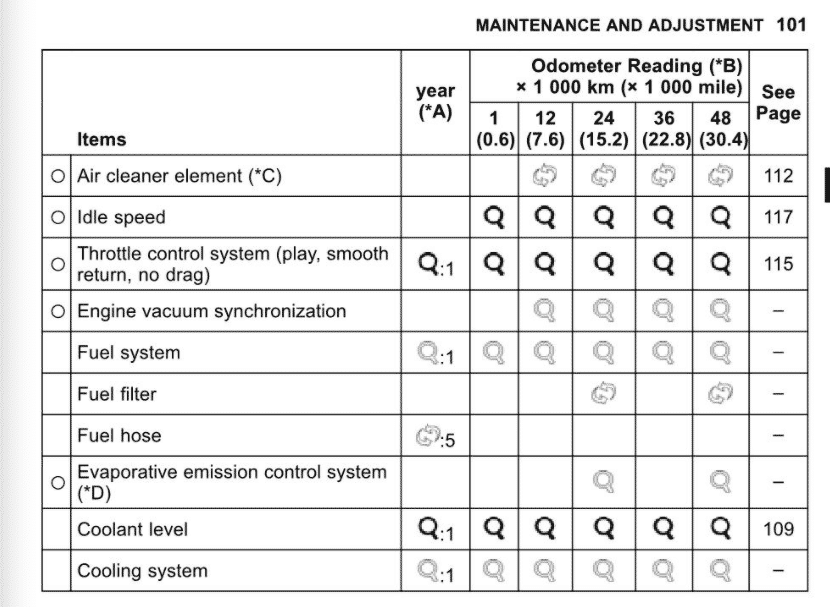
Here’s a copy of the manual in PDF format that you can download for archive purposes.
You can view it at Kawasaki’s website here.
